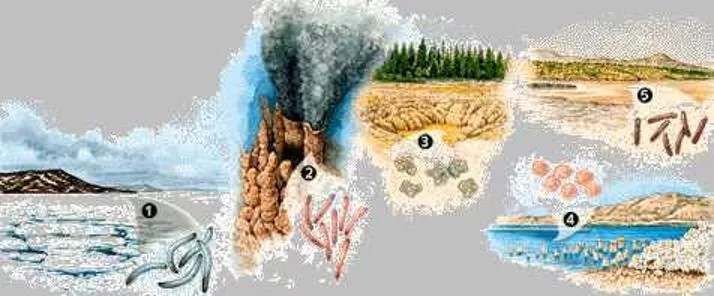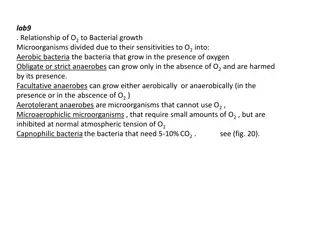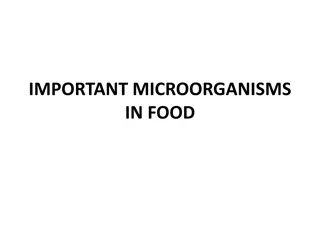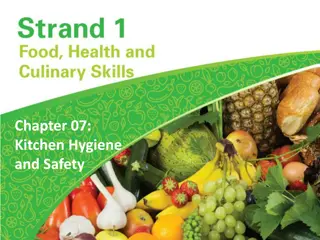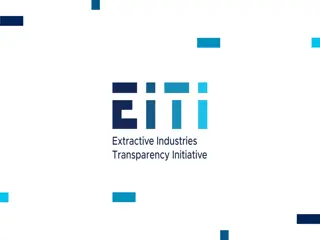The Role of Beneficial Bacteria in Food Production
Beneficial bacteria play a crucial role in food production, aiding in the production of items like yogurt, cheese, pickles, and more. They also contribute to fuel production and help improve digestive health. These helpful microorganisms are diverse, with various strains serving different purposes in the food industry.
Uploaded on Oct 01, 2024 | 0 Views
Download Presentation

Please find below an Image/Link to download the presentation.
The content on the website is provided AS IS for your information and personal use only. It may not be sold, licensed, or shared on other websites without obtaining consent from the author. Download presentation by click this link. If you encounter any issues during the download, it is possible that the publisher has removed the file from their server.
E N D
Presentation Transcript
FUEL PRODUCTION Archaebacteria produce methane gas, which makes up 20% of the world s natural gas used for fuel.
FOOD PRODUCTION Lactobacillus and other bacteria turn milk into buttermilk, sour cream, yogurt, and cheeses. Other bacteria turn apple cider into vinegar, and cucumbers into pickles.
DEFINITION DEFINITION Beneficial microorganisms Helpful bacteria and fungi that are either added or naturally occur in foods. Create unique flavors and textures or improve the body s ability to digest foods or fight disease.
MICROORGANISMS MICROORGANISMS INVOLVED IN DIFFERENT FOOD INVOLVED IN DIFFERENT FOOD . . Cucumbers Pickles Cabbage Sauerkraut Milk Yogurt, cultured buttermilk, cheese Meats Summer sausage, pepperoni
Micro-organisms in Milk The types of m.o found in milk vary considerably Bacteria, yeasts, moulds and bacteriophages are commonly encountered. Viruses and protozoa are seldom observed in milk, except as occasional contaminants.
Bacteria The most important bacteria used in food production are the Lactobacillaceae family. This family produces lactic acid from carbohydrates, resulting in changes in certain foods. Example: milk to yogurt.
Bacteria Most common and most numerous of m.o found in milk and milk products . + ++++ They belong to four main groups: Gram +ive cocci Gram +ive non-spore forming rods Gram +ive spore-forming rods Gram -ive non-spore forming rods. 1. 2. 3. 4.
Lactic Acid Bacteria Normally present in milk and they are also used as starter culture for the production of cultured dairy products. They ferment lactose and yield lactic acid.
LAB reclassified (older names in parenthesis). Lactococci L.delbrueckii sub sps.lactis (Str.Lactis) L. Lactis sub sps. Cremoris (Str. Cremoris) Lactobacili L. Casei L. delbrueckii sub.sps.lactis(L. Lactis). L. delbrueckii sub Sps. bulgaricus (L.bulgaricus) iii. Leuconostoc i. ii.
Yeast The most beneficial yeasts for food production are from the genus Saccharomyces. Yeasts produce desirable chemical reactions. Example: leavening of bread and production of alcohol.
Molds Molds from the genus Penicillium are associated with the ripening and flavor of cheeses.
1. BUTTERMILK, SOUR CREAM, KEFIR AND KOUMIS Different products are produced by using different strains of lactic acid bacteria as starter cultures and different fractions of whole milk as the starting substrate. Sour cream uses Streptococcus cremoris or S. lactis for producing lactic acid and Leuconostoc cremoris for characteristic flavour. Cream is starting substrate. Butter is normally made by churning cream that has been soured by lactic acid bacteria. Streptococcus cremoris or S. lactis is used to produce lactic acid rapidly and Leuconostoc citrovorum produces necessary flavors. Kefir and Koumis, popular in Europe are fermentation products of S. lactis, S. cremoris, other Lactobacillus spp and yeasts.
2. YOGHURT. How do we know there are beneficial microorganisms in yogurt? Are they listed in the ingredients? What does live active cultures mean on the container? Refers to the living organisms: L. Bulgaricus & S. Thermophilus Convert pasteurized milk to yogurt during fermentation Help support healthy digestion
3. CHEESE. Cheese consists of milk curds that have been separated from the liquid portion of the milk (whey). The curdling of milk is done by enzyme rennin (casein coagulase or chymosin) and lactic acid bacterial starter cultures. Cheeses are classified as soft (high, 50-80% water content), semi hard (about 45% water) and hard (a low water content, less than 40%). They are also classified as unriped if produced by single- step fermentation or ripened if additional growth is required during maturation of the cheese to achieve the desired taste, texture and aroma. Cottage and cream are soft, unripened cheese; Brie, Camembert and Limburger are soft, 1-5 months ripened cheeses; Blue, Brick, Gorgonzola, Monterey, Muenster and Roquefort are semi soft, 1-12 months ripened cheeses, whereas Cheddar and Colby are hard, 3-12 months ripened cheeses.
Natural production of cheese involves lactic acid fermentation, with various mixtures of Streptococcus and Lactobacillus spp. used as starter cultures. The flavour results from use of different microbial starter cultures, varying incubation times and conditions and the inclusion or omission of secondary microbial species late in the process. Ripening involves additional enzymatic transformations after the formation of cheese curd.
Swiss cheese formation involves a late propionic acid fermentation with ripening done by Propionibacteria shermanii. Various fungi are also used in the ripening of different cheeses. The unripened cheese is inoculated with fungal spores. Blue cheeses are produced by Penicillium spp. Roquefort cheese is produced by using P. roqueforti and Camembert and Brie by using P. camemberti and P. candidum.
SODA Microorganisms are used to make this can of soda? citric acid comes from Microbial source-Most common organisms used for production of citric acid are Aspergillus niger, Bacillus subtilis. Citrus fruit: lemons & limes Preservative; used to add an acidic or sour taste
SODA (CONT) Demand for citric acid went beyond what could be extracted from citrus fruit Industry needed an alternative Mold: 99% of the world s citric acid is produced with the help of this mold
FERMENTED FOODS Alcoholic Beverages Alcohol is produced from fermentation by the yeast Saccharomyces cerevisiae Bread Dairy Products Other Fermented Foods
PRODUCTION OF BREADS involves growth of Saccharomyces cerevisiae (baker s yeast) under aerobic conditions maximizes CO2 production, which leavens bread other microbes used to make special breads (e.g., sourdough bread ) can be spoiled by Bacillus species that produce ropiness
PRODUCTION OF ALCOHOLIC BEVERAGES Fermentation of fruit juice results in wine. Most wine is made from grapes. Beer and ale is produced by the fermentation of malted grains. Distilled beverages are produced by concentrating alcohol by distillation.
FERMENTED FOODS Beer Beer is dear Produced by the fermentation of malted grain Malted grain: Grain that has been allowed to germinate, then dried in a kiln & perhaps roasted Germinating the grain causes the production of a number of enzymes, most notably - and -amylase Malted grains that may be used are barley, rye, or wheat Unmalted grains, such as rice or corn, may also be used
BEER The starch in malt is converted to sugar by natural enzymes. Sugars are then fermented by yeasts. The aqueous extract (wort) is separated by filtration, hops added and boiled for several hours. Wort is then transferred to fermentation vessel (1-3 weeks). Yeast used is Saccharomyces carlsbergensis. Bottom-fermenting yeasts produce lagers Top-fermenting yeasts produce ales The beer may be disinfected either by cold filtration through a 0.45 m filter or by pasteurization
FERMENTED FOODS Wine Wine is Fine Produced from the fermentation of fruit juice, usually from grapes The grapes are crushed to form a must For white wines, white grapes are usually used, and the skins are removed from the must ( pressing ) before fermentation For red wines, red or black grapes are used, and the skin is allowed to remain during fermentation For ros wines, red grapes are used and the juice is allowed to remain in contact with the skins just long enough for a rose or pink color to develop
WINE PRODUCTION Grapes are harvested and crushed by machines and the juice called must, is squeezed out. Yeasts used can be of two types wild yeasts and Saccharomyces ellipsoideus. Fermentation is carried out in vats of various sizes made of various materials. Wine is separated from the sediment and then stored at lower temperature for aging. Dr. NAKADE RCK
FERMENTED FOODS Wine The must undergoes primary fermentation Natural yeasts on the skins of the grapes may be used, but in commercial production cultured yeast is often used to give more predictable results Malolactic fermentation by bacteria in the must converts malic acid into lactic acid After primary fermentation, the must is pressed (red wines) and transferred to different containers for secondary fermentation. Secondary fermentation and aging -Takes 3 6 months Done in either stainless steel vessels or in oaken barrels The vessel is kept airtight to prevent oxidation. Proteins are broken down, & particles settle Blending and bottling
FERMENTED FOODS Yogurt Milk is fermented by a mixture of Streptococcus salivarius ssp thermophilus and Lactobacillus bulgaricus (official name Lactobacillus delbrueckii ssp. bulgaricus). Often these two are co-cultured with other lactic acid bacteria for taste or health effects (probiotics). Acid produced from the fermentation causes the protein in the milk (casein) to coagulate into a semisolid curd For flavored yogurt, fruit are added after the yogurt is made.
CHEESE PRODUCTION Cheese is one of the oldest human foods and is thought to have developed approximately 8000 years ago. About 2000 varieties are produced throughout the world. All cheese results from a lactic acid fermentation of milk, which results in coagulation of milk proteins and formation of a curd. All the major cheeses produced by dairy fermentation are done by Streptococcus lactis.
FERMENTED FOODS Cheese Milk is treated with lactic acid bacteria and an enzyme called rennin that partially hydrolyses the protein and causes it to coagulate into curds. The liquid portion of the milk at this time is called whey. The whey is separated from the curds, and the curds are heated, pressed and then usually aged (ripened). Different microbes in the early and late stages of processing give rise to cheeses with different characteristics.
FERMENTED MILKS Dairy products can be fermented to yield a wide variety of cultured milk products. Fermented milks have therapeutic effects. Acidophilus milk is produced by Lactobacillus acidophilus. L. acidophilus may exhibit anticancer activity. Bifidobacterium-amended fermented milk products may also promote antitumorigenic activity.
MICROORGANISMS AS FOODS AND FOOD AMENDMENTS variety of bacteria, yeasts, and other fungi are used as animal and human food sources probiotics microbial dietary adjuvants microbes added to diet in order to provide health benefits beyond basic nutritive value
What are Probiotics Supplements? Probiotics are supplements made of beneficial, friendly lactic acid bacteria and formulated to reflect the composition of healthy gut flora They should be taken 2-3 times per day to restore healthy intestinal flora. Afterwards, on a daily basis in order to maintain healthy intestinal flora and help guard against diseases caused by pathogenic or putrefactive bacteria
Main Families of Lactic Bacteria Fig 1: Lactobacilli (Small Intestine) Large Intestine Small Intestine Fig 2: Bifidobacteria (Large Intestine)
Lactic Bacteria: Action Mechanism Lactic Acid Bacteria Act like a shield and mask receptor sites for pathogenic bacteria Lactic Acid Bacteria Act like a shield and mask receptor sites for enterotoxinogen pathogens Lactic Acid Bacteria Adhere to intestinal cells and protect them against pathogenic bacteria
REQUIREMENTS OF PROBIOTICS Probiotics must be alive Probiotics must be safe Probiotics must deliver a measured physiological impact Survival of gastrointestinal tract transit Probiotics needn t be restricted to food applications
EXPECTED BENEFITS ASSOCIATED WITH CONSUMPTION OF PROBIOTICS Increased tolerance to infections Control of diarrhea Reduction of blood pressure Cholesterol reduction Allergy control Cancer reduction
PROBIOTICS AND POULTRY A probiotic made up of 29 bacteria (PRE- EMPT) is being used in chickens. This establishes a functional microbial community in the cecum and limits Salmonella colonisation of the gut through competitive exclusion.
SINGLE CELL PROTEINS Refers to the dried cells of microorganisms such as algae, bacteria and fungi. Used as protein sources in animal feeds including human food supplements. E.g Pruteen - Made from the bacterium Methilophilusmethilotrophus. Spirulina cyanobacteria of the genus Arthrospira. Whole cells as well as beta carotenes from spirulina are available.
YEAST AS A FOOD SUPPLEMENT Yeast for nutritional purposes is cultivated in large aerated fermentors in a medium containing molasses as an ingredient. At the end of the growth period, yeast cells are recovered by centrifugation and washed. Nutritional yeast is heat-killed and usually dried. Yeast cells are rich in B vitamins and in protein.
MUSHROOMS AS A FOOD SOURCE Several kinds of fungi are sources of human food of which the most important are the mushrooms. The mushroom commercially grown in most parts of the world is Agaricus bisporus and is cultivated in mushroom farms. Fungus is grown under environmentally controlled conditions in a mixture of soil and organic matter.
ENVIRONMENTAL CLEAN-UP Some bacteria eat oil and turn it into environmentally friendly chemicals. These bacteria are dumped into waters contaminated by oil spills.
ENVIRONMENTAL RECYCLING Bacteria are decomposers: they break down dead organisms into smaller chemicals which then go back into the soil.
DIGESTION Many bacteria, such as human E. coli, live a warm and cozy life in your intestines. They help digest your food and make vitamins, such as Vitamin K (which is necessary for blood clotting).
DIGESTIVE HEALTH Beneficial bacteria, such as Lactobacillus, keep the bad bacteria in check, by competing with them for nutrients.
MEDICINES The pharmaceutical industry uses some forms of bacteria to make vitamins and antibiotics. Other bacteria can be used to produce insulin, which can be collected and given to people with diabetes.
FOOD CHAIN Bacteria are a food source for many small organisms!

 undefined
undefined






